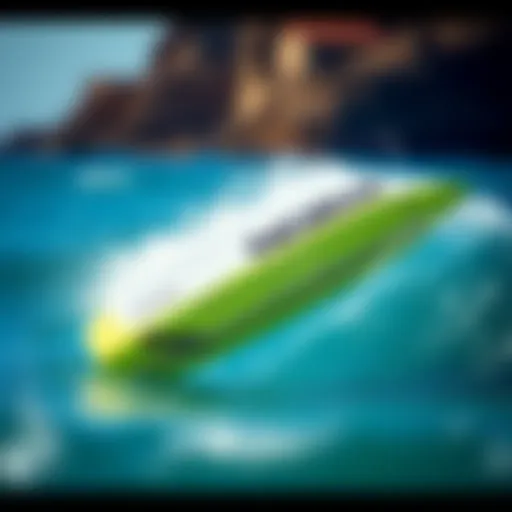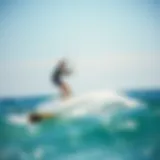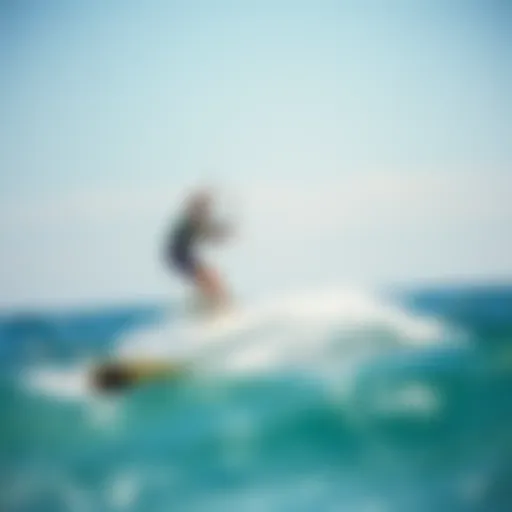Essential Guide to Kite Surfing Vests for Safety
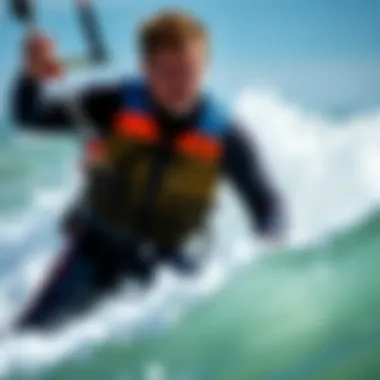

Intro
Kite surfing is an exhilarating water sport that demands both skill and the right gear for a safe and enjoyable experience. Among the essential equipment, kite surfing vests play a critical role. These vests are not just about style—they provide safety, improve performance, and enhance comfort while riding. Understanding the ins and outs of these vests can help enthusiasts choose wisely and elevate their water adventures.
In this guide, we'll dive into the various types of kite surfing vests available, explore their specific features, and offer insights on how to select one that fits your unique needs and the conditions you'll encounter. You’ll also be equipped with maintenance tips to prolong the lifespan of your gear, alongside a look at recent technological advancements in the vest industry.
Through this comprehensive exploration, you'll gain a stronger grasp on the significance of kite surfing vests and how they can impact not just your safety, but also your overall performance on the water.
"A well-fitted vest not only keeps you safe, it allows you to focus on the ride instead of worrying about your gear."
Let's first look at techniques that can help kiteboarding enthusiasts, ranging from beginners to advanced riders.
Preface to Kite Surfing Vests
When it comes to kiteboarding, the thrill that comes with gliding over waves can sometimes overshadow an equally crucial aspect: safety. Kite surfing vests play an integral role in this adventure sport. They not only protect riders from unforeseen mishaps but also enhance overall performance and comfort. In this section, we will discuss the significance of kite surfing vests and the essential benefits they bring to both seasoned riders and newcomers alike.
The Role of Safety in Kiteboarding
Safety should be at the forefront of any water sport, kiteboarding included. The open waters can be unpredictable, with sudden shifts in wind currents or unforeseen dips in waves. Here, having a kite surfing vest can be a game changer. Its primary function is to provide buoyancy, helping ensure that one stays afloat during an emergency situation. A vest can prevent drowning, giving the user precious time to regain composure or wait for assistance.
Furthermore, many vests come equipped with impact protection that cushions falls and hard landings, which are common when trying to master tricky maneuvers. Whether you're a novice learning the ropes or an experienced kiteboarder pushing the limits, safety gear is non-negotiable. In fact, many riding schools mandate that their students wear a vest, highlighting its importance early on in the learning process.
In essence, kite surfing vests are your safety net on the water, allowing riders to focus on the thrill of the ride rather than worry about what lurks beneath.
Importance of Proper Equipment
Choosing the right equipment can make all the difference in kiteboarding. A kite surfing vest isn't just an accessory; it's a crucial piece of gear that influences your performance, comfort, and, ultimately, enjoyment of the sport. Here are a few reasons why investing in the proper vest is paramount:
- Comfort: A well-fitting vest allows for unrestricted movement, enabling you to execute jumps and turns without feeling encumbered.
- Performance Enhancement: Good buoyancy helps keep you on top of the water, which improves your control and maneuverability. Because the right vest offers an optimal balance between floatation and flexibility, you won't have that cumbersome feeling that comes from wearing ill-fitting gear.
- Temperature Regulation: Depending on the material, some vests offer insulation while also being breathable, keeping you comfortable during long sessions in varying water temperatures.
The importance of proper equipment cannot be overstated. Without the right vest, even the best kiteboard setup can fall short, affecting how you ride and possibly leading to injury.
When in doubt, always prioritize your safety and comfort by equipping yourself with a quality kite surfing vest.
Types of Kite Surfing Vests
When it comes to kite surfing, choosing the right vest can make all the difference in safety and performance. Each type of vest serves a distinct purpose, and understanding their unique features is crucial for any kiteboarder. Here’s a breakdown of the main types of kite surfing vests you may encounter and what sets them apart.
Impact Vests
Impact vests are designed primarily to provide protection during falls. They are typically made from a blend of impact-resistant materials that cushion the body when you hit the water. A good impact vest can absorb shock, helping prevent injuries from hard landings.
These vests feature a snug fit that stays in place during extreme maneuvers. They often have padded sections around the ribs and spine, areas particularly vulnerable to injury in kiteboarding. Some models even have added buoyancy, though their primary function remains impact protection.
Key points to consider with impact vests include:
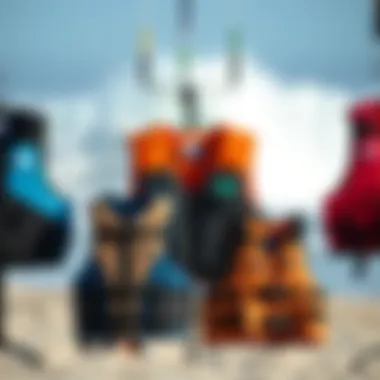

- Protection Levels: Look for vests with multiple layers of padding for enhanced safety.
- Flexibility: Ensure the vest allows for a full range of motion; after all, you want to perform tricks without feeling restricted.
- Neoprene Material: Many impact vests are made from neoprene, which adds to comfort while also providing some thermal properties.
Buoyancy Vests
Buoyancy vests, on the other hand, focus on keeping you afloat rather than on impact protection. They are filled with foam or another buoyant material that helps to keep you at the surface of the water in case of an accident. This feature is particularly important for beginners who may need extra confidence when they wipe out.
While buoyancy vests do provide some protection, their primary purpose is supporting the wearer in the water. This makes them great for those who are still mastering their skills or for use during very light winds. When selecting a buoyancy vest, consider:
- Rated Buoyancy: Each vest usually has a rating, indicating how much buoyancy it provides. Higher ratings are better for individuals who might struggle to stay afloat.
- Fit and Comfort: The vest should be close enough to the body to be effective without being restrictive. A vest that slips can be a safety hazard.
- Lightweight Design: Some buoyancy vests are designed to be lightweight and dry quickly. This can make a big difference in performance and comfort during longer sessions.
Hybrid Vests
Hybrid vests are the best of both worlds, combining the protective features of impact vests with the buoyancy of traditional flotation vests. They are an excellent choice for those who want the assurance of floatation without sacrificing protection during harder landings.
The key features of hybrid vests include:
- Versatile Usage: Great for varying conditions, allowing riders to navigate from calm to challenging waters easily.
- Integrated Padding: These vests often incorporate strategic padding that protects key areas while still providing buoyancy.
- Style Considerations: Many hybrid vests come in a range of styles and colors, appealing to those who want to express their individuality on the water.
"Choosing the right vest is critical not just for comfort but also for enhancing your performance and ensuring safety on the water."
Key Features to Consider
When diving into the world of kite surfing vests, understanding the key features is pivotal for optimizing your experience on the water. Selecting the right vest isn’t merely about aesthetics; it’s about ensuring your safety, enhancing performance, and maximizing comfort. Here are several considerations that can guide you in making an informed choice, focusing on materials, sizing, fit, and flexibility.
Materials and Construction
The choice of materials in kite surfing vests can make or break your time on the water. High-quality construction is crucial. Materials like neoprene or PVC are commonly used for their durability, yet there's more to it than just robustness.
- Neoprene Vests: Known for their excellent insulation properties, these vests not only offer protection against impacts but also keep you warm in cooler conditions. They can be thicker, providing more buoyancy but might restrict movement if not sized correctly.
- PVC Vests: These are lighter and typically offer better buoyancy. They can withstand various water conditions well, but sometimes lack the stretchiness of neoprene, which can hinder mobility.
Moreover, breathable fabrics or mesh linings help with ventilation, keeping you comfortable after a long session. Look for reinforced stitching and seams, as these indicate a vest that's built to endure the rigorous demands of kiteboarding.
Sizing and Fit
Getting the right size and fit is of utmost importance. An ill-fitting vest can be counterproductive, not to mention uncomfortable. A vest that's too tight may restrict blood flow and movement, while one that's too loose may not provide adequate safety.
- Measurement Guidelines: Pay attention to your chest and waist measurements and consult the manufacturer’s size chart to ensure a good fit. Some brands may use unique sizing, so it never hurts to try several on.
- Comfort Check: When trying on a vest, move around like you’re on your board. Bend, twist, and reach to see how it feels. If it rides up or feels constricting, keep looking. Remember, you want a snug fit without compromising on your range of motion.
Flexibility and Movement
Flexibility in kite surfing vests can significantly influence your performance. A vest that allows for a full range of motion will help you handle your kite better.
- Flexible Panels: Look for vests that feature flexible panels or designs that support movement. This can be particularly important when performing tricks or rapid directional changes.
- Wear and Tear: As these vests age, they may lose some of their elasticity. Regularly inspect your vest for signs of wear, as compromised flexibility can lead to injury on the water.
In essence, understanding these key features—materials, sizing, and flexibility—helps you choose a kite surfing vest that not only protects you but also complements your riding style, thus enhancing your overall experience.
"The right gear is essential for peak performance. When it feels good, you perform better."
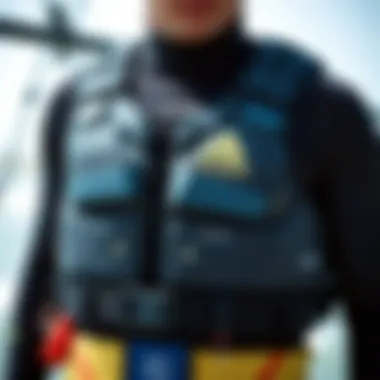

In closing, take your time when evaluating these essential features. A thoughtful selection process can lead to countless hours of enjoyment and safer adventures out on the waves.
Choosing the Right Vest
Choosing the right kite surfing vest is not just about style; it's about safety, comfort, and enhancing your overall experience on the water. A well-selected vest significantly contributes to your performance and confidence while kiteboarding. But what exactly should one consider when making this decision? Let's break it down into a few vital aspects.
Assessing Your Skill Level
When considering a vest, evaluating your skill level is crucial. Beginners might prefer a buoyancy vest that allows for extra floatation, helping to maintain stability as they learn the ropes. On the other hand, seasoned kiteboarders usually opt for impact vests that provide protection without sacrificing mobility.
Here’s a breakdown to help you:
- Beginners: Look for vests designed with high buoyancy. A quick-drying material can also be beneficial, as it makes the learning process more comfortable.
- Intermediate: You may want vests that strike a balance between buoyancy and impact protection. A hybrid model could serve you well as you continue to improve your skills.
- Advanced: A slim-fitting impact vest allows for full range of motion while ensuring maximum protection against falls and impacts.
Considering Water Conditions
The water you ride in heavily influences the type of vest you should choose. If conditions are calm with little to no waves, then a lightweight vest designs might suit you best. However, choppy or turbulent waters necessitate a more robust option. Here's what to think about:
- Flat Water: Opt for a vest that is more streamlined; this reduces drag and helps with agility as you ride.
- Wavy Conditions: Go for vests with added buoyancy. A thicker vest can keep you afloat and help prevent injuries when wiping out.
- Cold Water: A neoprene vest not only helps with warmth but offers some buoyancy as well. Ensure it has good insulation properties.
Personal Preference and Style
Each rider's style is unique, influenced by personal taste and the type of riding they prefer. The aesthetics and fit of the vest should mirror your personality and riding habits.
- Color and Design: Choose colors that reflect your personality; after all, kiteboarding is about enjoying yourself out there. Bright colors and patterns can also improve visibility, which is a safety consideration.
- Fit: Ensure the vest fits snugly yet allows freedom of movement. No one wants to feel like they’re stuck in a corset while trying to enjoy a session on the water.
A well-chosen vest complements your riding style while keeping you safe. Take your time to think about each element before making your choice. Remember, a kite surfing vest isn’t just practical; it’s a part of your kiteboarding identity.
"The right gear can make a world of difference in your kiteboarding adventures. Choose wisely!"
For more insights on choosing kite surfing equipment, visit Kiteboarding.com or explore discussions on Reddit.
Care and Maintenance of Kite Surfing Vests
Taking care of your kite surfing vest is as crucial as choosing the right one in the first place. The durability and performance of a vest depend greatly on how well it is maintained. Proper care not only extends its lifespan but also ensures that it remains effective in providing the safety and support needed while you're out riding the waves.
Regular maintenance teaches kiteboarders to be proactive rather than reactive. It's far easier to perform minor tasks to keep your vest in top shape than to contend with the repairs after damage has occurred. This section presents essential cleaning guidelines, storage recommendations, and tips for recognizing signs of damage.
Cleaning Guidelines
Maintaining cleanliness is vital for the longevity of your kite surfing vest. Saltwater and sand can weaken materials over time if not removed properly. Here's how to clean your vest without causing harm:
- Rinse After Use: Always rinse your vest with fresh water after each session. This simple action helps to wash away salt and debris that can cause wear and tear.
- Use Mild Soap: Occasionally, a thorough clean is needed. Use a gentle soap designed for sensitive fabrics—do not use harsh detergents.
- Cold Water Wash: If your vest is machine washable, opt for cold water. Hot water can damage the materials and cause shrinkage.
- Air Dry: Avoid the dryer. Lay your vest flat in a shaded area after washing. Direct sunlight can degrade the fabric over time.
By following these steps, you keep dirt and grime at bay, enhancing the performance of your vest and maintaining comfort on the water.
Storage Recommendations


When it comes to storage, where and how you keep your vest can make all the difference. After a day on the waves, it's important to store your vest correctly:
- Avoid Folding: Always hang your vest rather than folding it. Folding can create creases that weaken the fabric.
- Cool and Dry Place: Find a place that’s both cool and dry for storage. Humidity and heat can warp the materials and dictates how quickly it deteriorates.
- Use a Garment Bag: If you have space, using a breathable garment bag offers protection from dust while allowing the vest to breathe.
This way, when the next kite surfing adventure arrives, your vest will be ready without any surprises.
Recognizing Signs of Damage
It's crucial for kiteboarders to be vigilant and aware of any signs that their vest may be suffering from wear and tear. Noticing damage at an early stage can save time, hassle, and potential accidents. Here are some signs to look out for:
- Fabric Tears or Rips: Even a small tear can worsen quickly. Check for any fabric issues regularly.
- Discoloration: If you notice discoloration, especially in areas that often rub against other gear, it may indicate weakening of the fabric.
- Water Absorption: If your vest begins to absorb water rather than repelling it, the materials may have broken down, signaling that it’s time for a replacement.
- Unusual Sounds: Pay attention to any cracking or unusual sounds when moving your vest. This can point to internal damage.
Remember, a well-maintained vest not only enhances performance but is essential for safety on the water.
Caring for your kite surfing vest doesn’t have to be a chore. By routinely cleaning it, storing it properly, and keeping an eye on its condition, you’ll be ensuring that your vest serves you well for many thrilling rides on the ocean.
Recent Innovations in Vest Technology
In the world of kiteboarding, safety and performance go hand in hand, and the evolution of vest technology plays a pivotal role in enhancing both aspects. With every passing year, manufacturers tap into innovative materials and features that not only meet current safety standards but also exceed them. As kiteboarding gear becomes increasingly sophisticated, enthusiasts can benefit from vests that incorporate cutting-edge solutions designed specifically for their needs on the water.
Advancements in Safety Features
When it comes to safety, recent developments in vest technology have led to significant enhancements. The latest models are often designed with impact-absorbing materials such as polyethylene and high-density foam. These materials absorb shocks during a fall, reducing the risk of injuries significantly.
Additionally, some vests now come equipped with integrated flotation systems that enable riders to maintain buoyancy even after a significant impact. This could mean the difference between a minor setback and a major incident in the water. Moreover, with the addition of features like reinforced seams and ultra-durable outer layers, the lifespan of these vests has greatly improved, allowing kiteboarders to ride with peace of mind.
"Safety on the water is no laughing matter; these advancements in vest technology truly save lives."
Integration of Smart Technology
As the tech landscape advances, so does the integration of smart technology into kite surfing vests. Riders can now find vests embedded with GPS tracking systems and communication devices. This connectivity allows for real-time location sharing with friends or emergency services, enhancing safety during solo runs.
Some brands have even introduced vests with sensors that monitor body temperature and heart rate. By providing live feedback, they help users maintain optimal performance and alert them when they might be overexerting themselves. This not only results in better-prepared riders but also contributes to long-term health on and off the water.
Incorporating smart technology into vests might seem like a luxury, but it's becoming essential for many advanced practitioners. Having the ability to easily relay vital information can be crucial during incidents, especially in remote locations where help might be far away.
As these innovations continue to reshape the industry, kiteboarders can look forward to safety features that not only protect but also enhance their riding experience. With the right gear, they can enjoy the thrill of the water with added confidence.
Epilogue
As we come to the end of this guide, it's critical to grasp the vital role that kite surfing vests play in the overall kiteboarding experience. These vests are not merely accessories; they form an essential part of your safety gear while out on the water. In a sport that combines thrill and risk, having the right vest can mean the difference between a fun day on the water or a serious mishap.
Summary of Key Points
When considering your kite surfing vest, here are the main takeaways:
- Safety First: The primary purpose of kite surfing vests is to enhance safety. Whether you opt for impact vests for better protection during falls or buoyancy vests for floatation, prioritizing safety can prevent injuries and offer peace of mind.
- Type Matters: Understanding the various types of vests—impact, buoyancy, and hybrid—is crucial. Each has a distinct purpose, and matching the vest with your riding conditions and personal style can significantly enhance your performance.
- Key Features: Pay attention to materials, sizing, and flexibility. A vest should fit snugly without restricting movement, and its construction should withstand wear and tear from both the water environment and your activities.
- Technology Advances: Innovations in vest technology—like safety features and smart integrations—are constantly evolving. Staying updated on these can enhance your experience and comfort.
- Maintenance is Key: Proper care extends the life of your vest. Regular cleaning, safe storage, and identifying signs of damage can keep your gear in top-notch condition.
Final Thoughts on Selecting and Using Vests
Moreover, integrating the best practices for care and maintenance into your routine ensures that your vest, your shield on the water, will be fully operational whenever you need it. Engage with communities on platforms like Reddit, or visit resources such as Wikipedia to learn more from seasoned riders.
By following these guidelines and putting thoughtful consideration into your vest choice and care, you can maximize your kiteboarding experience. Go ahead, take the plunge into the world of kite surfing with confidence and style, equipped with the right vest—a fundamental part of navigating the waves safely.



